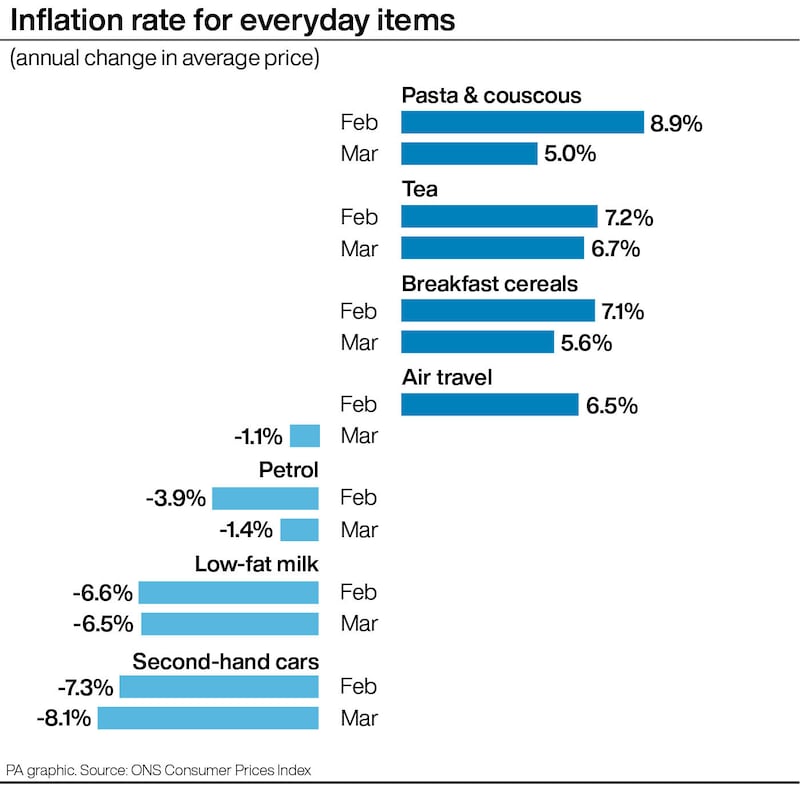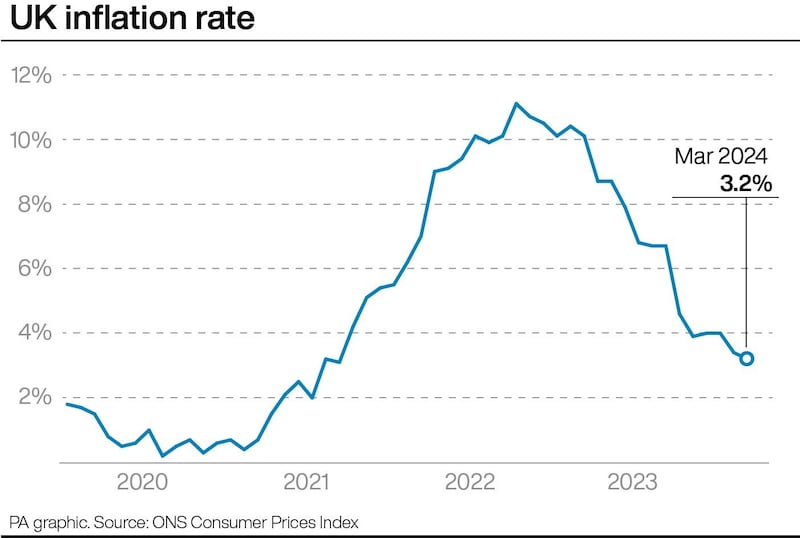Inflation fell to a fresh two-and-a-half year low in March as food price growth slowed sharply once again.
Food and non-alcoholic drink inflation dipped to 4%, down from 5% in February, to reach its lowest level since November 2021, according to the latest data from the Office for National Statistics (ONS).
A slowdown in price rises last month for many household groceries was partly offset by an increase in the cost of fuel and a jump in inflation for a handful of items.
Petrol continues to be cheaper than it was 12 months ago, though the 1.4% drop in the year to March was smaller than the 3.9% fall in the year to February, reflecting the recent rise in prices at the pumps.

The same trend is affecting the cost of diesel, which fell year-on-year by 7.4% last month, compared with a drop of 10.8% in February, according to Consumer Prices Index (CPI) figures published by the ONS.
Inflation is still accelerating for some everyday items including crisps (up 9.4% in price last month compared with 6.2% in February), soft drinks (up 3.8% compared with 2.4%), chocolate (up 9.8% compared with 8.9%) and eggs (up 3.9% compared with 3.2%).
But a growing number of products are continuing to record negative inflation – in other words, prices are falling year-on-year.
The average cost of whole milk was down 11.1% in the year to March, a slightly larger fall than the drop of 10.2% in February, while low-fat milk fell by 6.5%, broadly unchanged on a decrease of 6.6% in February.

Butter was down 11.7% in price in March, a steeper drop than the fall of 7.6% in the previous month, while second-hand cars were down 8.1% compared with a fall of 7.3% in February.
Frozen seafood fell more steeply in March (down 8.7%) than in February (down 4.0%), as did cheese and curd (down 1.6% versus a drop of 0.3%).
Meanwhile, margarine and other vegetable fats are now recording negative inflation, falling in price by 1.2% last month after rising 0.2% in February.
The cost of air travel was down by 1.1% in March after jumping 6.5% year-on-year in February.
There have also been sharp slowdowns in the average price of pasta and couscous, which rose by 5.0% in March compared with 8.9% in February; women’s clothes (up 5.2% in March compared with 7.1% in February); and cinema, theatre and concert tickets (up 5.4% compared with 8.5%).
Below is a list of examples of how the CPI inflation rate has either slowed or accelerated.
Two figures are listed for each item: the average rise in price in the 12 months to February, followed by the average rise in price in the 12 months to March.
– Examples where inflation has slowed, ranked by the size of the change:
Pasta products & couscous: Feb up 8.9%, Mar up 5.0%
Sugar: Feb 17.6%, Mar 14.2%
Cinemas, theatres & concerts: Feb 8.5%, Mar 5.4%
Frozen vegetables other than potatoes: Feb 11.7%, Mar 8.8%
Sauces, condiments & culinary herbs: Feb 8.2%, Mar 5.9%
Meat: Feb 5.0%, Mar 3.1%
Women’s clothes: Feb 7.1%, Mar 5.2%
Breakfast cereals: Feb 7.1%, Mar 5.6%
Fresh or chilled fruit: Feb 4.3%, Mar 2.8%
Children’s clothes: Feb 5.7%, Mar 4.5%
Mineral or spring waters: Feb 9.5%, Mar 8.3%
Potatoes: Feb 8.5%, Mar 7.6%
Passenger train travel: Feb 4.3%, Mar 3.4%
Rice: Feb 3.9%, Mar 3.3%
Fast food/takeaway food: Feb 6.6%, Mar 6.0%
Tea: Feb 7.2%, Mar 6.7%
– Examples where inflation has accelerated:
Crisps: Feb up 6.2%, Mar up 9.4%
Purchase of pets: Feb 9.2%, Mar 11.3%
Soft drinks: Feb 2.4%, Mar 3.8%
Chocolate: Feb 8.9%, Mar 9.8%
Fruit & vegetable juices: Feb 7.7%, Mar 8.6%
Coffee: Feb 0.1%, Mar 0.8%
Eggs: Feb 3.2%, Mar 3.9%
Ready-made meals: Feb 4.1%, Mar 4.6%
Pizza & quiche: Feb 1.0%, Mar 1.4%









